You might not have noticed, but most modern hotels hide their stairways. Depending on who you ask, this is either for safety, security or aesthetics (stairwells are ugly, unless you design them to match the other decor) – but it means that people tend to be surprised when they see you running up them. I find a huffed-out “Morning!” is one of the best ways to break the tension. A lot of those you meet walking downstairs in hotels at 7am are probably quite hungover, or at least groggy. Still, they’re usually very polite.
I know this because – and this feels like a slightly embarrassing admission – I’m a Stairs Guy now. It’s always been a lurking part of my psyche, in one way or another: I’ve never been able to stand on the right on the underground, or wait for a lift if it’s only going a couple of floors. Still, I’m not alone. Stair-running is a pastime on the rise, at least if you look at the amount of events catering to it. The first ever full-scale tower race, reportedly, took place at the Eiffel Tower in 1905, with about 300 runners climbing a mere two levels (729 steps) of the monument. More events followed, but it took a while before the sport spread to the UK (via an inter-university race up the BT tower in 1968), and the US (the Empire State Building Run-Up debuted in 1978). Today, hundreds of events across dozens of countries allow the light-limbed and large-lunged to race each other up some of the world’s most recognisable skyscrapers, while everyone else is gently encouraged to pace themselves to the top.

But why? Well, it really depends on the athlete. “My first love is running, and I miss track racing terribly, but it’s tough on the body after many years – so stair climbing worked very well for me,” says Suzy Walsham, who competed in the Commonwealth Games in the 800m and 1500m in 2006 before making the move to stair running. “There’s much less impact, but it’s still incredibly challenging – and I love that the real race is between you and the building. My first race was the Swissôtel Vertical Marathon in Singapore. The first prize was a trip to New York to do the Empire State Building Run-Up, and I quite liked the idea of a free trip to New York. I won the race, and went to New York, and won the Empire State Building Run-Up, too. That was the start of my stair-climbing career. Initially there were not many races and I would only do three or four a year. I had a child in 2010 and came back, and by 2012 there were many more races and the sport just kept growing.”
Stair running has plenty to recommend it besides the views, starting with a lack of impact: Walsham isn’t the only runner to have taken up the sport because it’s easier on the joints. There’s also a total-body aspect to the sport that can take beginners by surprise: “Because you’re going up, you’re using all of the major muscle groups in your legs to generate the power needed to gain height – quads, glutes, calves, hip flexors and hamstrings,” says the competitive stair climber David Harris, who works with the London Landmarks Skyscraper Challenge. “But it’s not only legs – the vast majority of buildings will have handrails that can be used to pull yourself up and take some of the load off. They can also help minimise time on the landings by helping you to slingshot around on to the next flight.”
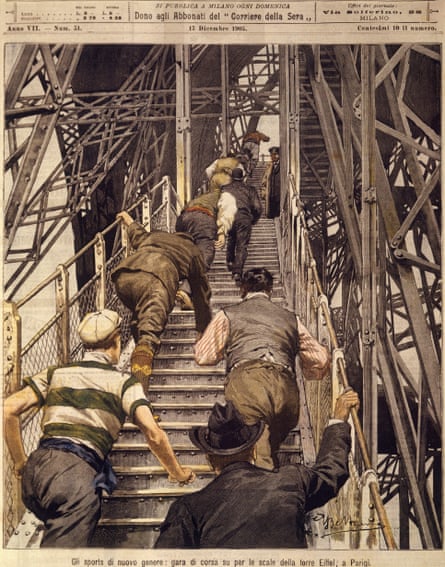
Banister technique might bring a technical aspect to the sport, but otherwise there’s a bracing purity to it that many runners enjoy. “Unlike a track or road race, tactics don’t come into it much, as it’s very difficult to change pace on the stairs,” explains Walsham. “Managing your pace in the initial stages is critical, as if you reach your max lactic threshold early on, it’s very difficult to recover from it. It’s also a very individual sport and probably two-thirds of the elite races are time trials – so it’s you against the building and the clock.”
And, of course, it’s fast. Elite runners will sprint up the 1,576 steps of the Empire State Run-Up in less than 10 minutes; the record for the 920 steps of London’s Tower 42 is under four. Marathon runners often struggle as stair racers require lactic acid tolerance and a degree of anaerobic fitness (which kicks in when you’re moving too fast to use oxygen for fuel) as well as the aerobic kind used for longer efforts. “I’ve been faster in the stairs than people who were 10 minutes faster than me over a half marathon,” says Walsham.
This is where we come back to me huffing up six flights of purple-carpeted stairs in a Holiday Inn Express. As a busy dad, I don’t have the time to go out on the leisurely Sunday 10-milers that I used to, but I still value my cardiovascular fitness – likely to be a key predictor of all-cause mortality. High-intensity aerobic intervals are pretty good for building this up – and stair sprints are perfect. “Running on steps increases intensity, so you can get a more efficient workout over a short physical distance and in a short interval of time,” says Sarah Aarons, a personal trainer who regularly incorporates stairs into her outdoor classes. “This means step running lends itself to a number of different interval-based formats and a range of abilities. Steps also add extra options for incorporating other exercises, which is useful for making workouts easier or harder – for example, an incline press-up using five steps is suitable for a beginner, while a decline press-up using three steps is a very advanced exercise.” Five sets of six flights – with a handful of press-ups at the top and a walk down to recover – takes me fewer than 10 minutes, but it’s a pretty solid workout for the day, even if it means getting some funny looks on the ascents.
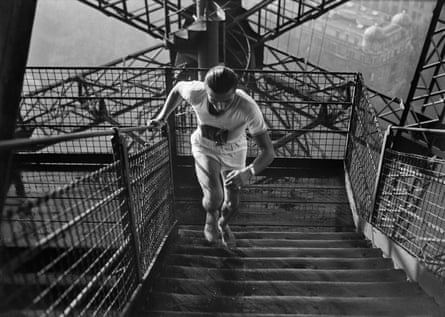
Of course, if even this feels too much, there are plenty of benefits to just taking the stairs occasionally: ignoring the lift at work, popping up a couple of flights when you’re on your lunch break or dashing up the escalator at Angel station (with 27.5m of vertical rise, it’s the longest in the underground).
“I think the main reason to embrace stairs would be to think of them as ‘exercise snacks’,” says Brady Holmer, a runner and researcher at examine.com. “Stair climbing is pretty vigorous v walking, and you can do it throughout the day to accumulate short bouts of high-intensity activity,” he adds. “In one recent study, for instance, test subjects who did squats – which have a lot of similarities with stair climbing – throughout an otherwise inactive day saw improved protein synthesis compared with a control group, which might lead to benefits for strength and muscle. Basically, stairs can be a great way to break up sedentary time with exercise during the day, which has metabolic benefits and might even improve fitness.”
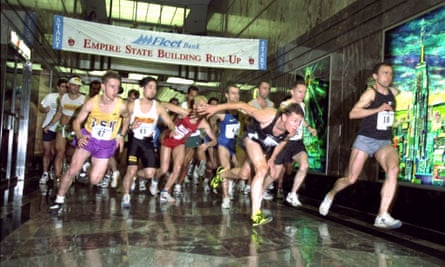
In other words: it’s time to embrace the climb. It’s a form of exercise that’s built in to many buildings, doesn’t require any extra kit and is over in minutes – or seconds – rather than hours. If you end up loving it, you might find yourself travelling the globe to race up famous spires – like Walsham, who says she’s made friends all over the world – or getting engaged at the top of the Eiffel Tower, like Harris and his (fellow stair-runner) wife. If all that sounds too much like hard work, of course, you can always simply relish the faint glow of effort as you sit down at your desk for the day after a nippy nine flights – or just, for a second, enjoy the view from the top.
Stepping it up
Want to try stair running in the comfort of your own home/office/local landmark? Try one of personal trainer Sarah Aarons’ “pyramid” options below – the difficulty increases with each round, then tapers off in the second half. Take it easy at first, have a break if you’re feeling lightheaded and be careful on the way down.
Beginner
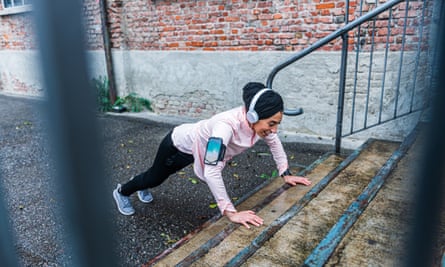
-
30 seconds: walk or jog to top of steps, do two “half jacks” – basically, a star jump without moving your arms – at the top and run down. Repeat as necessary.
READ RELATED: Expectant mothers like me feel we’ve been abandoned to Covid | Letter
-
45 seconds: walk or jog steps, do two half jacks and two squats at the top. Repeat.
-
60 seconds: walk or jog steps, do two jacks, two squats, and one “stepping” burpee – for this, you’ll squat down, put your hands on the floor, step back into a press-up position, then reverse the whole movement to stand up again. Repeat.
-
Repeat in reverse.
Intermediate
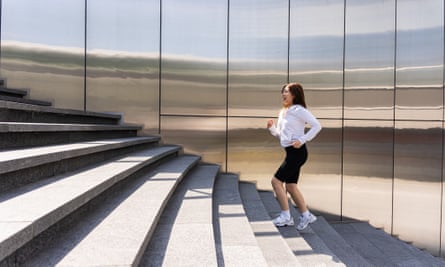
-
30 seconds: jog or run steps, do three star jumps, run down. Repeat.
-
45 seconds: jog or run steps, do three star jumps and three jump squats, run down. Repeat.
-
60 seconds: jog or run steps, do three star jumps, three jump squats, three burpees. Repeat.
-
Repeat in reverse
Advanced

-
30 seconds: run steps, do four “star bursts” – squat down, then explode into a star jump – at the top, then run down. Repeat.
-
45 seconds: run steps, do four star bursts, then four mountain climbers – from a press-up position, bring one knee and then the other to your chest. Repeat.
-
60 seconds: run steps, do four star bursts, four plank jacks – get into a plank position and hop your feet out to about double shoulder-width, then back in again – then four burpees. Repeat
-
Repeat in reverse.




